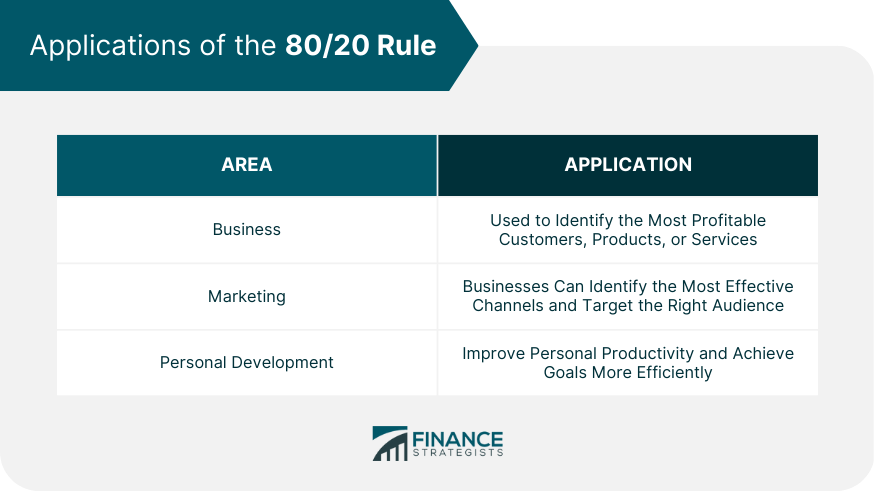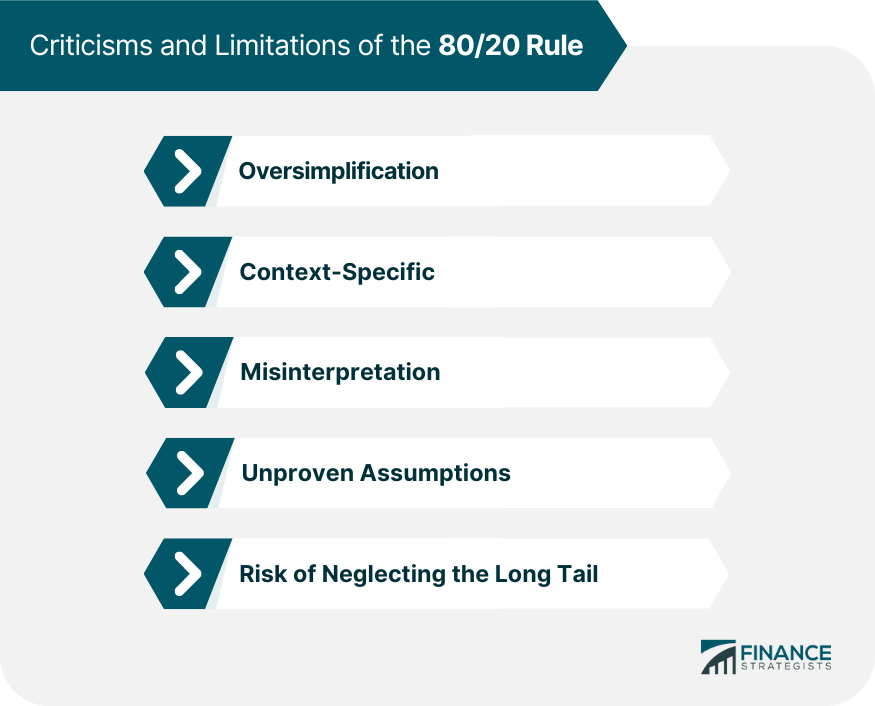The 80/20 rule, also known as the Pareto Principle, is a concept that states roughly 80% of the effects come from 20% of the causes, meaning that a small number of inputs have a disproportionate impact on the outcome. The rule has since been applied in various fields, including economics, management, marketing, and personal development, to identify the most important factors that contribute to a particular outcome and to allocate resources more efficiently. The 80/20 rule is a general principle and should not be used as a strict formula. The origins of the 80/20 rule can be traced back to the Italian economist Vilfredo Pareto, who observed in the late 19th century that 80% of the land in Italy was owned by 20% of the population. Pareto later observed that this principle applied to many other areas, including wealth distribution, income distribution, and even crop yields. The 80/20 rule gained popularity in the 1940s when management consultant Joseph Juran applied it to quality control in manufacturing. Juran observed that 80% of defects in a product were caused by 20% of the process variables and that by identifying and optimizing these variables, manufacturers could improve their quality and efficiency. Since then, the 80/20 rule has been applied in a wide range of fields, including economics, management, marketing, and personal development. While the exact ratio of the rule may vary depending on the context, the principle remains the same: a small number of inputs have a disproportionate impact on the outcome. Critics of the 80/20 rule argue that it oversimplifies complex systems and that the ratio may not always hold true in practice. However, proponents of the rule argue that it provides a useful framework for identifying the most important factors that drive performance and for prioritizing resources and efforts accordingly. Although used widely in business and economics, it also has applications in marketing and personal development. The 80/20 rule can be used to identify the most profitable customers, products, or services. By analyzing sales data, businesses can determine which customers generate the highest revenue and which products or services are the most profitable. This information can then be used to focus the company's resources on the most valuable segments and products while phasing out or optimizing less profitable ones. The 80/20 rule can also be applied to resource allocation, where companies can prioritize investments in areas with the highest impact on their bottom line. For example, a company that spends 80% of its marketing budget on channels that generate only 20% of its sales could benefit from reallocating its resources to more effective channels. Similarly, a company that invests 80% of its R&D budget on projects that yield only 20% of its innovation output could benefit from re-prioritizing its research efforts. The Pareto Principle can also improve decision-making by focusing on the most important factors that drive performance. Instead of getting bogged down in irrelevant details, managers can use the 80/20 rule to identify the few key factors that impact their objectives most and then allocate their resources accordingly. Using the 80/20 rule can help business owners and managers make more informed and effective decisions, ultimately leading to better outcomes. The 80/20 rule is also widely used in marketing, where it can help businesses identify the most effective channels and target the right audience. By analyzing customer data, companies can determine which channels generate the most revenue or leads and which segments of customers are the most profitable. This information can then be used to optimize marketing campaigns and allocate resources more efficiently. For example, a company that spends 80% of its marketing budget on social media channels that generate only 20% of its leads could benefit from funneling its resources to more effective channels, such as email marketing or search engine optimization. Likewise, a company that targets 80% of its advertising to a broad audience that generates only 20% of its sales could benefit from re-focusing its messaging and targeting a more specific and profitable audience. The 80/20 rule can also help companies maximize their return on investment (ROI) by identifying the campaigns that generate the most revenue or leads for the least cost. Companies can optimize their marketing budget and achieve better results with fewer resources by focusing on the channels and campaigns with the highest ROI. The 80/20 rule can also be applied to improve personal productivity and achieve goals more efficiently. By focusing on the 20% of tasks that generate 80% of the results, individuals can maximize their time and effort on the most crucial factors contributing to their success. For example, a student who spends 80% of their time studying topics that contribute only 20% of their grades could benefit from re-prioritizing their study time on the most important topics. A professional who spends 80% of their work day on low-priority tasks that yield only 20% of their productivity could benefit from delegating or outsourcing those tasks and focusing on the most important ones. The 80/20 rule can also help individuals reduce stress and overwhelm by prioritizing their tasks and activities and concentrating on the ones with the highest impact on their goals. The Pareto Principle can help people achieve better results with less effort and feel more in control of their time and productivity. Despite its wide use and application, the 80/20 rule has been criticized, and its limitations pointed out. Consider the following: Critics argue that the 80/20 rule is too simplistic. It tends to neglect complex systems and that multiple factors may contribute to an outcome. For example, in a business, there may be several factors that contribute to customer loyalty or product profitability, and it may not always be possible to identify a single 20% that contributes to 80% of the outcome. The 80/20 rule may not always hold true in all contexts or industries. For instance, in some industries, such as finance or healthcare, the ratio may be closer to 90/10 or 70/30. The exact ratio of the rule may also vary depending on the market conditions, customer segments, or product categories. The 80/20 rule is sometimes treated as a strict formula when it is a general principle. The rule should be used to identify the most important factors that contribute to a particular outcome, rather than an exact equation for resource allocation or decision-making. The 80/20 rule is based on general premises, such as the assumption that a small number of inputs have a disproportionate impact on the outcome, or that the distribution of outcomes follows a power law. These assumptions may not always hold true in all contexts, and the rule should be cautiously used. The Pareto Principle may lead to neglecting the long tail or the less frequent and less profitable segments. While 20% may contribute to the majority of the outcome, the remaining 80% may still be important for niche markets, customer segments, or product categories. The 80/20 rule is a powerful concept that can be applied in various fields to identify the most important factors contributing to a particular outcome. In business, the rule can help companies identify their most valuable customers, products, or services, and allocate resources more efficiently. In marketing, the rule can help companies identify the most effective channels and target the right audience to maximize ROI. In personal development, the rule can help individuals prioritize their tasks and activities and achieve their goals more efficiently. Common criticisms of the Pareto Principle revolve around oversimplification, context-specificity, misinterpretation, unproven assumptions, and the risk of neglecting the long tail. While the 80/20 rule may not hold true in all contexts, it provides a useful framework for identifying the few key factors that have the greatest impact on performance and for focusing resources and efforts on those factors. Seek expert advice from a qualified financial advisor or wealth management professional to maximize how the 80/20 rule can help you reach your financial, personal, and business goals.What Does the 80/20 Rule Mean?
History and Evolution of the 80/20 Rule
Application of the 80/20 Rule
In Business
In Marketing
In Personal Development

Criticisms and Limitations of the 80/20 Rule
Oversimplification
Context-Specific
Misinterpretation
Unproven Assumptions
Risk of Neglecting the Long Tail

The Bottom Line
What Does the 80/20 Rule Mean? FAQs
The 80/20 rule, also known as the Pareto Principle, states that roughly 80% of the effects come from 20% of the causes, meaning that a small number of inputs have a disproportionate impact on the outcome.
The 80/20 rule can be applied in business to identify the most profitable customers, products, or services. By analyzing sales data, companies can determine which customers generate the highest revenue and which products or services are the most profitable. This information can then be used to focus the company's resources on the most valuable segments and products while phasing out or optimizing less profitable ones.
The 80/20 rule is also used in marketing to identify the most effective channels and target the right audience. By analyzing customer data, companies can determine which channels generate the most revenue or leads and which segments of customers are the most profitable. This information can then be used to optimize marketing campaigns and allocate resources more efficiently.
Yes. Critics argue that it oversimplifies complex systems and that multiple factors may contribute to an outcome. Additionally, the exact ratio of the rule may vary depending on the context, and the rule should be used as a general principle rather than a strict formula.
The 80/20 rule can help decision-making by focusing on the most important factors driving performance. Instead of getting bogged down in irrelevant details, managers can use the 80/20 rule to identify the few key factors that impact their objectives most and then allocate their resources accordingly. This can help them make more informed and effective decisions, ultimately leading to better outcomes.
True Tamplin is a published author, public speaker, CEO of UpDigital, and founder of Finance Strategists.
True is a Certified Educator in Personal Finance (CEPF®), author of The Handy Financial Ratios Guide, a member of the Society for Advancing Business Editing and Writing, contributes to his financial education site, Finance Strategists, and has spoken to various financial communities such as the CFA Institute, as well as university students like his Alma mater, Biola University, where he received a bachelor of science in business and data analytics.
To learn more about True, visit his personal website or view his author profiles on Amazon, Nasdaq and Forbes.











